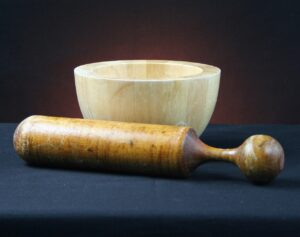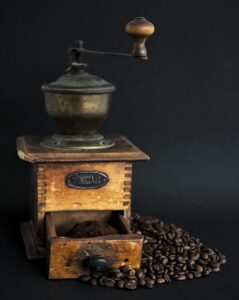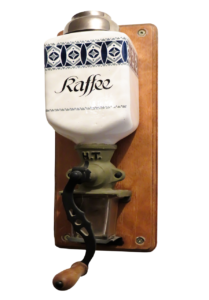
Ahhh! Breathe it in—the aroma of fresh ground coffee beans. What a delightful detail to enhance the scene in a writer’s story.
But when and how can a writer introduce a coffee bean grinder?
There are four (4) distinct periods in the life of coffee grinders:
- Stone Mortar and Pestle:

The exact date of the discovery of coffee beans is unknown, however, it can be tracked back to Ethiopia as early as 800 A.D.. As folks explored how to include the coffee bean in their lifestyles, the concept of grinding them naturally followed. The mortar and pestle got the job done and was utilized from that time and into the 15th century.
- Manual Grinder:
In the 15th century, innovative minds used the blueprints for operating grain mills to develop smaller-sized mills, or grinders, which were then used to grind spices. Subsequently, the grain mills and spice grinders proved useful to grind coffee beans also.

In its early stages of development, manual coffee bean grinders were often built with wood, in a box shape, with a turning handle on top. The user would pour the beans into the top of the grinder, turn the handle, and the grounds would fall into a removable drawer at the bottom.

Over the next couple centuries, coffee grinders morphed with such changes as: grinders specifically for coffee beans; mechanics using burrs instead of blades; and a wall-mounted coffee grinder. The late nineteenth century brought about mass production of cast iron grinders for use in households, cafes, and grocery stores.
- Electric Grinders:
By the early 20th Century, electric grinders became popular. In the next years, various inventors and companies presented design modifications, experimented with different materials for construction, and added features like measuring weights.
- Technology-Enhanced Grinders:

At the turn of the 21st Century modern technology wowed the public with features like Bluetooth, Wi-Fi, and touch-less. From coarse to fine, the beans could be ground to fit one’s taste buds. Add temperature control, anti-clumping and even the ability to measure density, and one can brew that perfect cup of coffee for the need of the moment without leaving their home.
Coffee grinders weren’t only about the mechanics to produce the perfect cup of coffee. Throughout changing eras and cultures, artisans left their marks. Those plain, boxy, practical devices became canvases for paint, etchings, and engravings. Beautiful devices were fashioned, bringing delight into homes then and joy into the hands of collectors now.
There are several ways a writer can utilize a coffee grinder in a story:
- The grinder can be a strong focus or a minor detail thread throughout the story.
- Just about any place a character might gather, coffee (and the grinder) can play a part: breakfast, business meetings, casual or formal gatherings, dates, holidays, wedding celebrations or funerals.
- Manual grinders open the door to four hundred years of design and artistry available to enhance a story—plots, scenes, or characters.
- Depending on the era and the type of coffee grinder chosen for the story, a writer can reveal “old-fashioned or quirky” characters. They can show patience (or impatience) of the character learning how to use that new electric grinder, or frustration when approaching high-tech Wi-Fi technology. Share family history—Gramma’s precious hand-me-down.
- No matter what the setting or period, a tense conversation might be amplified by the force a character uses to grind those coffee beans. Or perhaps an edgy conversation could use a little levity, and a discussion about dark beans and light beans and just the right ratio of the two might fit the need. Teasing an aficionado may provide the perfect injection of humor.

And there’s so much more for the writer’s creative mind to ponder.
Ahhh! Breathe it in—whiffs of aromatic possibilities.

Jeannine Brummett lives in South Carolina with her husband of nineteen years, Don, who shares his three adult sons and three grandchildren with her. Reading is big on her list of things to do, but she also thrives on TV crime dramas, NBA basketball, and marvels at the critters and fowl life that live at the pond behind their house. She loves to sing praise songs, attend Bible Study, and help at a local food pantry.




No Comments